As a proverb says, “Hunger is the best spice”. This is especially true for your little pet – they seem to be hungry all the time, and also eager to eat anything that you give them.
But that does not mean you should let your pup eat all of the leftovers or stick to the same canned dog food each day.
Let’s face it – nothing can beat homemade food.
What about dogs?
Ditto – homemade dog food is superb, period.
It takes some skills and knowledge to apply to become a skilled cook for your dog’s homemade dog food.
Luckily, you’re in the right place!
Last Updated: [todaysdate format=”F jS Y”]
Why Should You Care About Homemade Dog Food?
There is nothing more vital for me than my dog’s health. I’m continually trying to learn more about improving his diet, and let me tell you that it is science, my fellow pawrents.
There are so many things you need to learn before even thinking about the significant change. I will try to pass on my knowledge to you so you can make your decision easier than I did.
Just like humans, every doggo is an individual for itself. That means dietary requirements will be different from dog to dog. So I started with some basics. I asked myself am I willing to exclude kibble completely?
If we switch to homemade dog food, do I have the time to prepare his meals daily, or will it be more like a few times a week? And lastly, did I overcome the fear of feeding him raw?
Many of you would think this is not such a big deal and how it can’t be so hard to prepare quality homemade dog food. Thinking like – don’t use spices, poach the meat and add some veggies and you are good to go. Well, you might be wrong.
It’s all about nutrition guidelines for different dog breeds.
The problem is that you can even give large amounts of homemade food to your dogs and still starve them. By starving, I mean nutritionally deficient food that won’t satisfy their needs, and it will affect their health in the long run.
To sum it up, you should start home feeding (at least partially) your dog if you:
- Want your doggo to live a healthy & happy life
- Want to prevent possible health issues that may occur
- Have enough time to prepare the meals daily
- Optimize your dog’s diet
- Are ready to study my nutrition guide below
What Is Kibble And Why You Should Quit It?

Have you ever tasted a kibble (hope not)? Imagine how would you feel about eating that same dry food for every meal for the rest of your life.
Awful, right? Welcome to your dog’s reality.
Let’s talk about why it is wrong to base your dog’s diet solely on the kibble.
On the side that plain, dull food would make you unhappy you must ask yourself – is that food really good for your body?
Is it nutritionally balanced? Can you thrive and improve on it?
I don’t think so.
Let me explain to you what kibble is.
By term of kibble, I mean highly-processed commercial, dry pet food that is made from cooked ingredients like meat remnants, mixture of grains (rice bran, wheat mill run, corn bran, modified corn starch), and fillers (potato, peanut hulls, cottonseed hulls, feathers, citrus pulp, straw, weeds).
Lastly, all kibbles contain preservatives to prevent molding and prolong their expiration date.
A short insight into the process of producing kibble:
Reasons to dump kibble
Preservatives are very well known to be toxic for both humans and animals so do I need to tell anything more?
I don’t want to scare you or put you in a state of panic, but you need to know what toxic ingredients processed food contains and how they can affect your dog.
Let’s see what toxic ingredients can be found in your dog’s kibble:
- Carcinogens – The most known carcinogens that almost all brands of kibble contain are heterocyclic amines and acrylamide. There are several more carcinogens that may lead to some consequences, but these two are the fatal ones.Amines are a result of cooking poultry, fish, and meat; they are associated with mutations in an animal cell that can cause cancer as an end result. Acrylamide is an organic compound widely used in the food industry. They will occur when amino acids and sugars are exposed to high temperatures. When an animal cell absorbs acrylamide, it is converted into several different compounds that will react with cell DNA and can cause genetic mutations and tumors.
- Toxic additives – Some stabilizers and thickening agents like Xanthan gum and carrageenan can cause digestive problems like bloating and diarrhea.
- Synthetic ingredients – Don’t be fooled by thinking that vitamins in kibble are from natural sources. They are all born in a lab, and they are not suitable for animal consumption.
- High carbohydrate content – We can never know the exact amount of carbohydrates in kibble. Usually, they are above 17%, which is a huge amount for a dog that has normal daily activities, so this way, your dog is slowly led to obesity.
- Indigestible proteins – To get a better position on the market, many manufacturers claim how their food is high in protein. But what they are not telling us is what amount of these proteins are digestible. Dogs need proteins that come from natural resources and can be digested with ease.
- PBDE – Polybrominated diphenyl ether is present in kibble in larger amounts. They are responsible for liver damage, memory loss, behavioral changes, and disruption of the thyroid gland.
Common consequences that occur by consuming kibble:
- Allergies and skin problems – Not all allergies and skin problems can be blamed on kibble, dogs can react like that on various kinds of food. For example, my pup Jimmy is highly allergic to the chicken protein, no matter if it is in the form of kibble, raw, or thermally processed. The point is that kibbles are full of foods that your dog would normally not come across. Allergies lead to skin problems causing your dog to itch and scratch, which further can lead to some serious infections.
- Inflammations – Feeding your dog with food that is not normal for them to eat will lead to chronic inflammation like IBD (inflammatory bowel disease).
Why Feeding Your Dog With Homemade Dog Food?
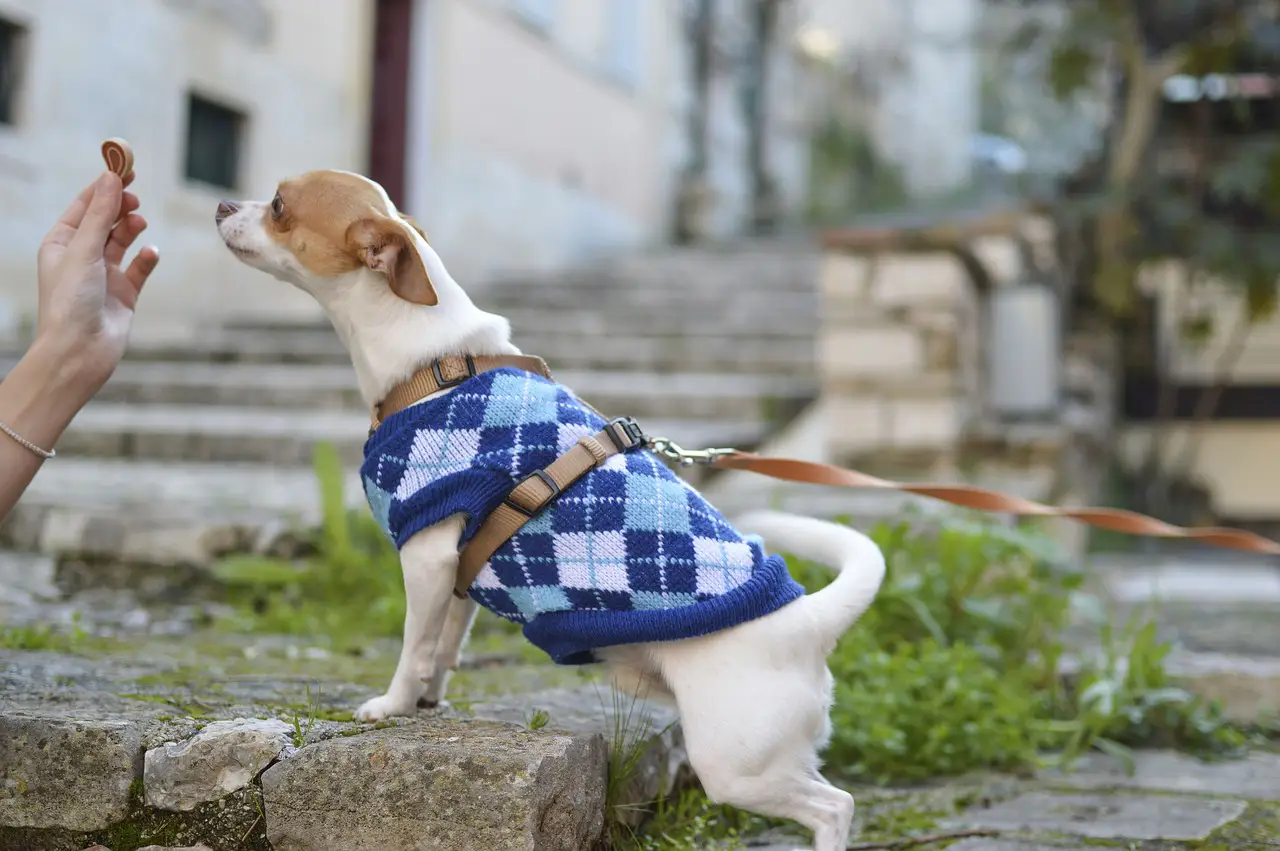
Dogs are omnivores, just like humans are. That means feeding them strictly with meat is not the best option. They are a species outstandingly adaptable to a wide range of ingredients, and they need veggies in their diet too.
To maintain good health and to prosper, dogs need at least 10% of their total calories to come from digestible proteins, no matter if they are animal or plant-based.
The required amount will increase as your dog ages, and it can go up to 50%. Those are amounts that industrial food can’t provide.
Also, proteins contain ten essential amino-acids that dogs can’t produce on their own, so the only way is to take them from food.
Carbohydrates include sugar, dietary fibers, and starch. Dietary fibers are crucial for maintaining gastrointestinal health.
Approximately, dogs need around 4.5% of total calories to come from fibers.
If your dog suffers from obesity, the solution is in increasing fiber intake to allow your dog to feel full without risk of consuming too many calories.
As I already mentioned, processed food contains more than 17% of carbohydrates (mostly starch and sugar) because they are mainly based on starchy veggies that are low in fibers.
So it is not hard to conclude how they are not a good source of fibers for your dog. Fibers are great for managing hyperglycemia, but too much fiber can cause diarrhea, so be careful.
Dietary fats and fatty acids come from animal fats and seed oils, and they are the most valuable source of energy in your dog’s diet.
Adult dogs need at least 5.5% of calorie intake to come from healthy fats. Remember, processed food is poor in good dietary fats and fatty acids.
So the main reason why you should feed your dogs with homemade food is to make sure your dogs are taking a proper amount of macronutrients that commercial food can’t provide.
As you can see, most diseases are caused by inadequate nutrition.
Guidelines for making a balanced homemade meal for your dog
No matter if you choose to cook homemade food or to feed raw, these guidelines will help you assemble a complete and balanced meal that will satisfy your dog’s nutritional needs.
But let’s not get overboard with this. Of course, it is not possible to make every meal to be 100% balanced unless you feed them with the same meal every day, which I don’t recommend.
Don’t be afraid to get creative and include new ingredients in their diet.
The point of homemade food is to include a wide variety of ingredients that will be beneficial to your dog, and you should spread those ingredients throughout the whole week and not include them in every meal.
On this link here, you can easily calculate daily calorie intake for your dog. This will help you to determine the exact amount of each food group.
Meat and other animal derivatives

This food group should always make around 50% of your dog’s calorie intake. You must be aware if you decide to feed your dogs with raw meat, they can easily consume much more fat than they need, and that leads to obesity. Also, this way, they will suffer deficiencies of other macronutrients.
If your dog is practicing regular but moderate activity, make sure you feed them lean meats with no more than 10% fat.
If your choice is poultry, make sure you remove the skin and feed them with dark meat since the breast is really low in fat and is more suitable for a low-fat diet.
For other meats like lamb, beef, ham, and pork, make sure to remove all separable fat.
Organs are significantly important if you decide to feed raw or homemade food since they are a source of essential nutrients.
What is crucial for you to know is that organs must always be served raw or if your dog is a picky eater lightly seared, but the middle must remain raw. The heart is a great option if you are on a budget, or you want to downsize the consumption of red meat.
To learn more about organs in dog’s diet click here.
Organs like the liver are very nutritious, and it is recommended to feed your dog with smaller amounts of liver every day or every other day more than giving them large amounts from time to time.
If you are including liver in a daily meal, make sure there is around one ounce of liver per pound of any other animal product.
Fish is a great source of vitamin D; if your dog doesn’t want to eat fish you must supplement vitamin D.
To make sure you are feeding your dog with enough fish you should use this equation; one ounce of fish per one pound of other meats including bones if you decide to incorporate them too.
Raw meaty bones (RMB) are not a must, but they are a great source of calcium and great for dental health.
In my case, I don’t use them (I supplement calcium), but you can. If you decide to try feeding them to your dog, check up on this link to learn how to include RMB in your dog’s diet.
Make sure that RMB makes around one-third of your dog’s diet. You can use chicken necks, tights, or backs. Bones are always served raw never ever cook them to avoid splinters that can be hazardous for your dog.
Eggs and dairy
Eggs are great for your dog’s health. Consumption depends on your dog’s size. Dogs from 20 pounds and above should take one egg per day, dogs that weigh under 20 pounds should take less.
Dairy is high in fat, so you must be careful. Also, just like humans, some dogs are lactose intolerant, so they should avoid dairy in any case.
A dog’s daily consumption of dairy products should not go above 10% of their calorie intake.
Fruits, veggies, and grains
You would never think that animals that evolve from wolves would need fruits and veggies in their diet, but believe me, they do.
As I mentioned, dietary fibers are crucial for their overall health and are great support for their digestive tract.
Veggies can be starchy or non-starchy. Starchy veggies (beans, potatoes, pumpkin) must always be cooked, or dogs won’t be able to digest them.
Quantities should be limited, especially if your dog has weight problems. Non-starchy veggies are very low in calories and should be included in a diet in the form of purees so your dog could digest it. Of course, in moderation, since they can cause bloating and gases.
Fruits are good choices for treats. In the link I posted above, you will be informed how many calories per day you should spend on treats, so base the fruit intake around that.
Grains are tricky food since it is known that they can cause allergies and inflammations. They must be well cooked, or they will make a mess in your dog’s digestive tract.
I recommend you to use white and brown rice, oatmeal, and sometimes barely. Veggies and grains together should make around 40% of daily calorie intake.
If you’re more of a visual type, here’s a presentation on great fruits and vegetables for your dog:
What dietary supplements are a must?
This greatly depends on whether you feed raw or cooked. If the food is cooked or frozen, longer than it should be, naturally, more nutrients will be lost.
Also, if you can’t feed your dog with a variety of foods or you must avoid some of the food groups I mentioned above, you will need to compensate with supplements.
Calcium
If you decide not to include raw meaty bones in your dog’s diet as I did, you must supplement calcium.
To satisfy your dog’s calcium needs, you should give 800 to 1000 mg of calcium per pound of food excluding dairy, and non-starchy veggies that already have some calcium in it.
You should use any type of plain calcium; I prefer grounding eggshells till I get a fine powder, 1/2 of tablespoon provides around 1000mg of calcium.
In a table below, I enlisted foods that my pup love to munch on, and they are a great source of calcium.
Food Item | Serving Size | Estimated Ca in mg |
|---|---|---|
Cottage cheese 1% milk fat | 4 Oz | 70 |
Ricotta cheese, part-skim | 4 Oz | 335 |
Yogurt low-fat (Greek) | 6 Oz | 200 |
Yogurt low-fat (plain) | 6 Oz | 300 |
Broccoli cooked | 8 Oz | 60 |
Kale cooked | 8 Oz | 95 |
Soybeans, matured, cooked | 8 Oz | 175 |
Oats | 4 Oz | 58 |
Salmon pink, canned with bones | 3 Oz | 180 |
Sardines, canned in oil with bones | 3 Oz | 325 |
Oils
Each type of oil supplies different nutrients, so it is very important to include a variety of oils in your dog’s diet.
Fish oil will provide EPA, DHG, omega-3 fatty acids that will help to reduce inflammation and will boost your dog’s immune system.
Remember, you will need to include fish oil only on days when your dog does not consume fish.
You should give around 300 mg of a combination of EPA and DHG per 20 pounds of body weight.
Cod liver is a great source of oil; it will provide your dog with vitamins A and D. If your dog is not a fish lover, this oil is your best ally.
You should dose cod liver oil in an amount to provide 500 IUs of vitamin D per 100 pounds of body weight.
Plant oils are rich in essential omega-6 fatty acids and linoleic acid. If you can’t feed your dog with dark poultry meat, you must find a way to compensate for insufficient amounts of those acids.
Use oils from corn, soybean, walnut, canola, hempseed, safflower, and olives. Use a teaspoon of oils per pound of meat or two teaspoons if you use canola oil.
Vitamins
It is evident that the more restricted the diet is, the supplementation becomes more important, primarily if you don’t feed your dog with organ meat (spleen, kidney, liver, heart) or enough veggies.
Vitamin E is problematic in almost all homemade diets at the beginning. When you supplement your dog’s food with oils, the need for vitamin E increases.
Make sure you only give 1 IUs or 2 IUs of vitamin E per pound of bodyweight on a daily basis; too much vitamin E can be counterproductive.
Vitamin | Daily dose for adult dogs per 33 lbs of body weight |
|---|---|
Vitamin A | 379 µg |
Vitamin D | 3.4 µg |
Vitamin E | 8 mg |
Vitamin B1 | 0.56 mg |
Vitamin B6 | 0.4 mg |
Vitamin B12 | 9 µg |
Vitamin K | 0.41 mg |
Riboflavin | 1.3 mg |
Niacin | 4 mg |
Choline | 425 mg |
Folic Acid | 68 µg |
Pantothenic Acid | 4 mg |
Minerals
Iodine is a tricky mineral since both deficit and surplus can suppress thyroid function. Kelp is a good source of iodine.
Be very strict when giving iodine to your dog and provide around 300 micrograms per 50 pounds.
You can always opt for supplements that combine multivitamins and minerals, but be aware that those types of products have a decent amount of vitamins but are very low on minerals.
If this is the way you want to supplement your dog, be aware that one pill per day is enough for a dog that weighs around 50 pounds.
If you serve the food from this list to your dog, make sure to customize iodine supplement to meat required daily dose.
Food Item | Serving Size | Estimated I in mg |
|---|---|---|
Cod | 3.5 Oz | 256 |
Tuna, fresh | 3.5 Oz | 18 |
Tuna, canned | 3.5 Oz | 12 |
Eggs | 3.5 Oz | 50 |
Dairy products | 3.5 Oz | 30-63 |
Antioxidants
Antioxidants play a prominent role in dog’s overall health on long runs by protecting cells from damage that can be caused by ‘’free radicals’’.
Best antioxidants for your dog are selenium, vitamins C and A, phytoplankton, coenzyme Q-10, lutein, and lycopene.
Probiotics and prebiotics
The main purpose of adding probiotics to your dog’s diet is to help fight pathogenic bacteria like salmonella, E. coli, campylobacter, and listeria.
Also, good bacteria from probiotics will improve digestion by assisting in the production of digestive enzymes.
If you decided to feed your dog with a combination of kibble and raw using probiotics and prebiotics is a must!
Introducing probiotics into your dog’s diet must be gradual. So take a glance at the table below.
Weight | Starting dose | After 1 week | After 2 weeks |
|---|---|---|---|
1 – 20 lb | 1/2 tsp once a day | 1 tsp once a day | 1 tsp twice a day |
21 – 50 lb | 1 tsp once a day | 1 tsp twice a day | 2 tsp twice a day |
50 + lb | 2 tsp once a day | 1 tsp once a day | 1 tsp twice a day |
Apple cider vinegar
Organic apple cider vinegar is essential if you are including raw meat and bones in your dog’s diet.
It will help to lower pH in your pup’s gut so he will be able to absorb more nutrients from the food.
Vinegar will also contribute to the safety of your dog by killing 80-99 % of harmful bacteria in the food. Add one tbsp per 50 pounds of body weight.
Which human food is safe for your dog, and which is not?
Most people think that this is a universal list and that all dogs can eat these foods without any consequences. This is not correct.
Before you start giving your dog human food, you should first talk about it with your vet. No dog breed is the same.
For example, Jimmy is an English bulldog, and they can’t consume milk, egg-white, tomatoes, peas, and they should avoid bacon (Jimmy regrets this every day).
So ask your vet or at least ask Google to find what your dog’s breed should avoid for any cost.
Human food that is safe for a dog:
- Meat – use skinless and boneless lean chicken and turkey, beef, liver (raw or cooked), lamb, tuna, salmon.
- Veggies – boiled potatoes (avoid red and brown potatoes) and sweet potatoes, leafy greens like lettuce and kale, broccoli and cauliflower (occasionally), carrots, cucumbers,brussels sprouts, peas.
- Fruit – bananas, berries, watermelon, apples, pears feed min small portions to avoid an upset stomach
- Dairy – milk (not suitable for all breeds), cottage cheese, ricotta cheese, hard cheese (American cheese, gouda) plain yogurt in moderate amounts
- Grains – always use cooked whole grains like wheat, brown and white rice, quinoa, oatmeal
- Eggs – to avoid the risk of salmonella I prefer to boil eggs until hard, as I mentioned you can use eggshell as a supplement just bake them for ten to fifteen minutes and grind them into a fine powder
- Peanut butter – only organic from time to time in the form of a treat
- Pasta – without sauce won’t harm your dog but remember pasta is full of starch so it might be not the best option
Stop and take a look at what a professional vet says on this:
Human food that is toxic for your dog:
Avocado – contains a substance called persin that is toxic for dogs
Processed meat – toxic for dogs and will lead to pancreatitis, kidney damage
Onion, garlic, chives – substance named organosulfoxides is toxic for dogs and will lead to vomiting and stomach pain
Alcohol – never give it to your dog if consumed can cause coma and death
Coffee and tea – contain methylxanthines highly toxic for dogs; can cause abnormal heart rate, seizures, vomiting, and sometimes even death
Macadamia nuts – can cause poisoning, weakness in muscles, and lethargy
Xylitol – is a substitute for sugar and it can be found in many snacks and sweets, very toxic for dogs, can cause liver failure
Grapes, currants, sultanas, and raisins – even small amounts can cause kidney failure and death
Chocolate – contain methylxanthines highly toxic for dogs; can cause abnormal heart rate, seizures, vomiting, and sometimes even death
Yeast dough – this refers to a raw dough that can keep expanding in dogs stomach and cause dangerous complications
If in any case, you doubt that your dog might have consumed any of these harmful foods, don’t wait to see if it will manifest any symptoms, visit your vet as soon as you can.
Energy Requirements For Dogs

Omgosh squirrel!!!
To sustain normal daily activities, dogs need energy. Different size, age, and breed dictate how much energy an individual dog needs.
That is not all; pregnancy, lactation, growth, and activity increase energy requirements.
So let’s learn a bit more about this matter:
(click on a category you want to learn about)
How To Make Homemade Dog Food?

Hey, pal, please, read this!
First, you must know how much homemade food your dog needs daily. Adult dogs should eat 2% or 3% of their body weight. If your dog is very active, you can feed him up to 5% of his body weight, while the sedentary dogs should stick around 2%.
One more important thing you must know is to divide food into two meals. If your dog is suffering from any kind of digestive tract disease, feed him with smaller amounts of food a few times a day. Here I will present you with a few examples.
Adult dog’s weight | Daily amount of food |
|---|---|
5 lb | 1.5 – 2.5 oz |
10 lb | 3 – 5 oz |
15 lb | 5 – 7 oz |
20 lb | 6.5 – 9.5 oz |
25 lb | 8 – 12 oz |
30 lb | 9.5 – 14.5 oz |
35 lb | 11 – 17 oz |
40 lb | 13 – 19 oz |
45 lb | 14.5 – 21.5 oz |
50 lb | 1 – 1.5 lbs |
75 lb | 1.5 – 2 lbs |
100 lb | 2 – 3 lbs |
Smaller dogs that don’t weigh above 10lb should be fed at the high end of the range since they have a faster metabolism.
Larger dogs that weight above 100 lb should be fed with lower-end range since they have a slower metabolism. The safest way is to keep the food amount in the middle range.
You don’t need to cook food every day. You can make a batch of food that you can keep in the fridge for approximately three days.
Dogs digest food better if it is at room temperature, so make sure to warm it up before serving. You can easily reheat the food by floating dog food bowls in a larger bowl of hot water.
In the beginning, you will have a hard time to calculate calories for each dog’s meal, so I recommend you to try using this awesome quick dog meal calculator.
Michael’s Top Recipes for Homemade Dog Food
Now that you’re informed about the ingredients and nutrients of your dog’s balanced diet, I want to share some of my (and my dog’s) favorite recipes.
After all, I am adamant that recipes do not exist without the cook that makes them.
So, feel free to experiment and add your own signature to these if you feel like you can adapt them to your dog.
Just make sure to carefully calculate the amount, i.e., calorie intake for your dog, and keep in mind all the guidelines so that there is no deficient or excess of the crucial ingredients.
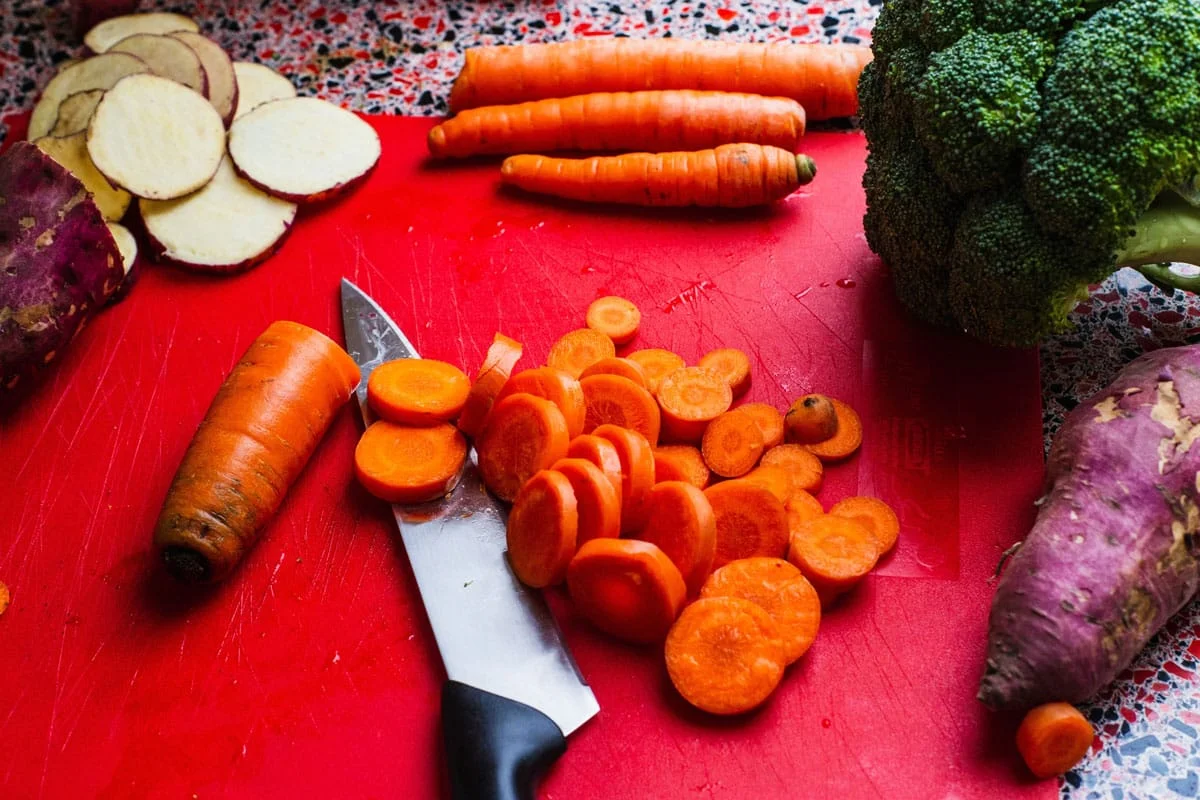
#1 Balanced Ground Turkey & Veggies Plate for Your Pal
This recipe is a perfect representation of a healthy, balanced homemade dog meal.
Not only that – dogs seem to love it!
Ingredients:
- 800g ground turkey
- 1 cup of brown rice
- 1 tbsp olive oil
- 2 cups baby spinach
- 2 shredded carrots
- 1/2 shredded zucchini
- 1 cup frozen peas (I skip this step since my doggo can’t eat peas, or sometimes I use broccoli instead)
Preparation time:40 minutes
- Cook rice
- Cook ground turkey with olive oil
- Add the veggies and rice
- Stir until it is heated and the ground turkey becomes brown
- Don’t forget to let it cool
- Give your dog a plate of health
What dogs is this recipe for?
- From 10 up to 45kg
- All breeds that do not have diet-specific regulations
- 15 month-old and up
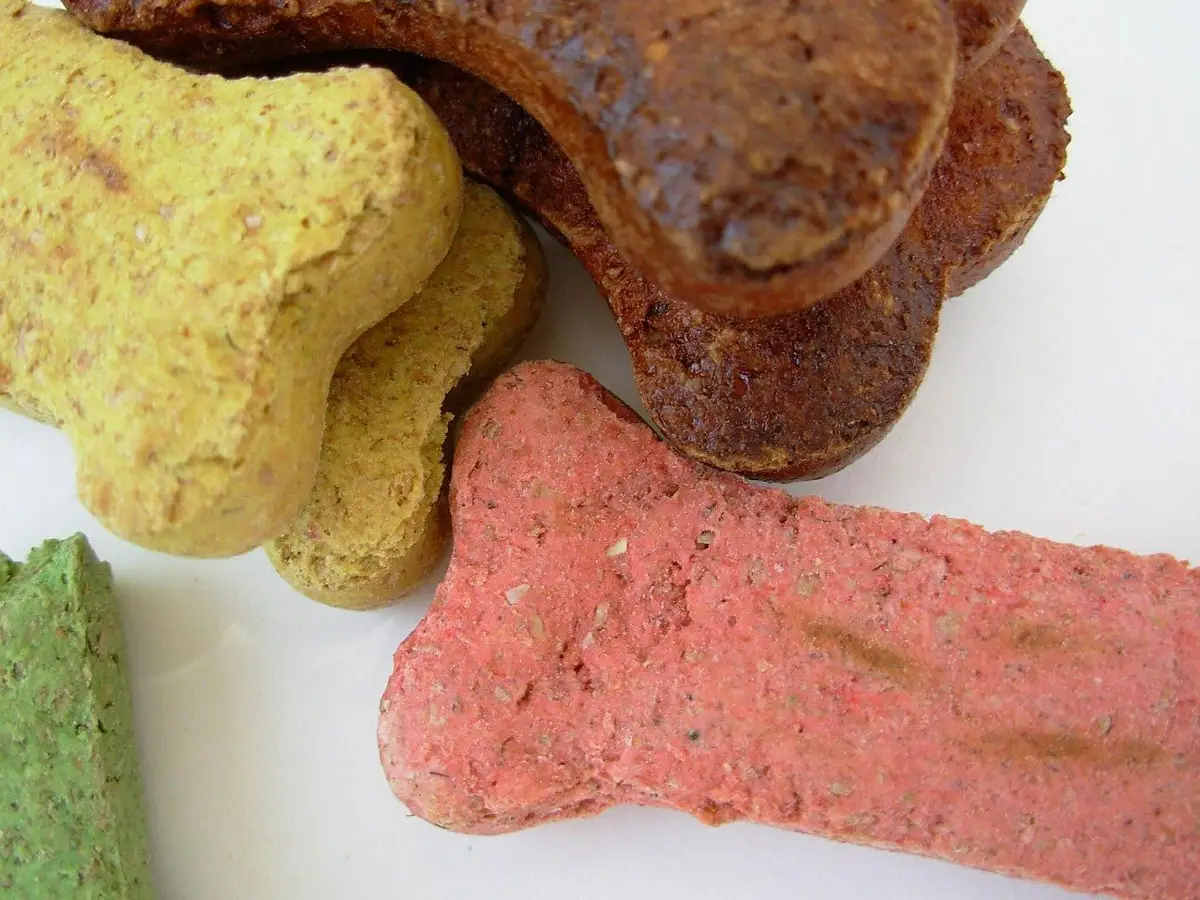
Yummy!
#2 Paradise Homemade Treats
All dogs love rewards – and you don’t need to and should not, spare your dog this joy because you’re home feeding.
Again, it is best not to overdo it. Treats are for special occasions, and your dog should eat a moderate amount of these.
Ingredients:
- 1 cup oatmeal
- 1 banana
- 1 cup peanut butter or pumpkin puree
- 1 egg
- 2 tsp water
NB: You can use either peanut butter or pumpkin puree for the mixture. Only use the former if you can find natural peanut butter, and always check the label to see if it contains Xylitol, which is harmful for your dog.
Preparation time: 1 hour
- Preheat oven to 356°F
- Grind oatmeal
- Mix the peanut butter or pumpkin puree, egg, and water in a bowl
- Add mashed banana into the mixture (the more banana and peanut butter/pumpkin puree you put in, the thicker the dough will be)
- Mix everything with the oats
- Cut treats into shapes
- Bake for 15-20 minutes
- Let it cool
What dogs is this recipe for?
- Do not have allergies and breathing problems
- 10 kg and up
- 10 months and up
- Those who have learned a new trick
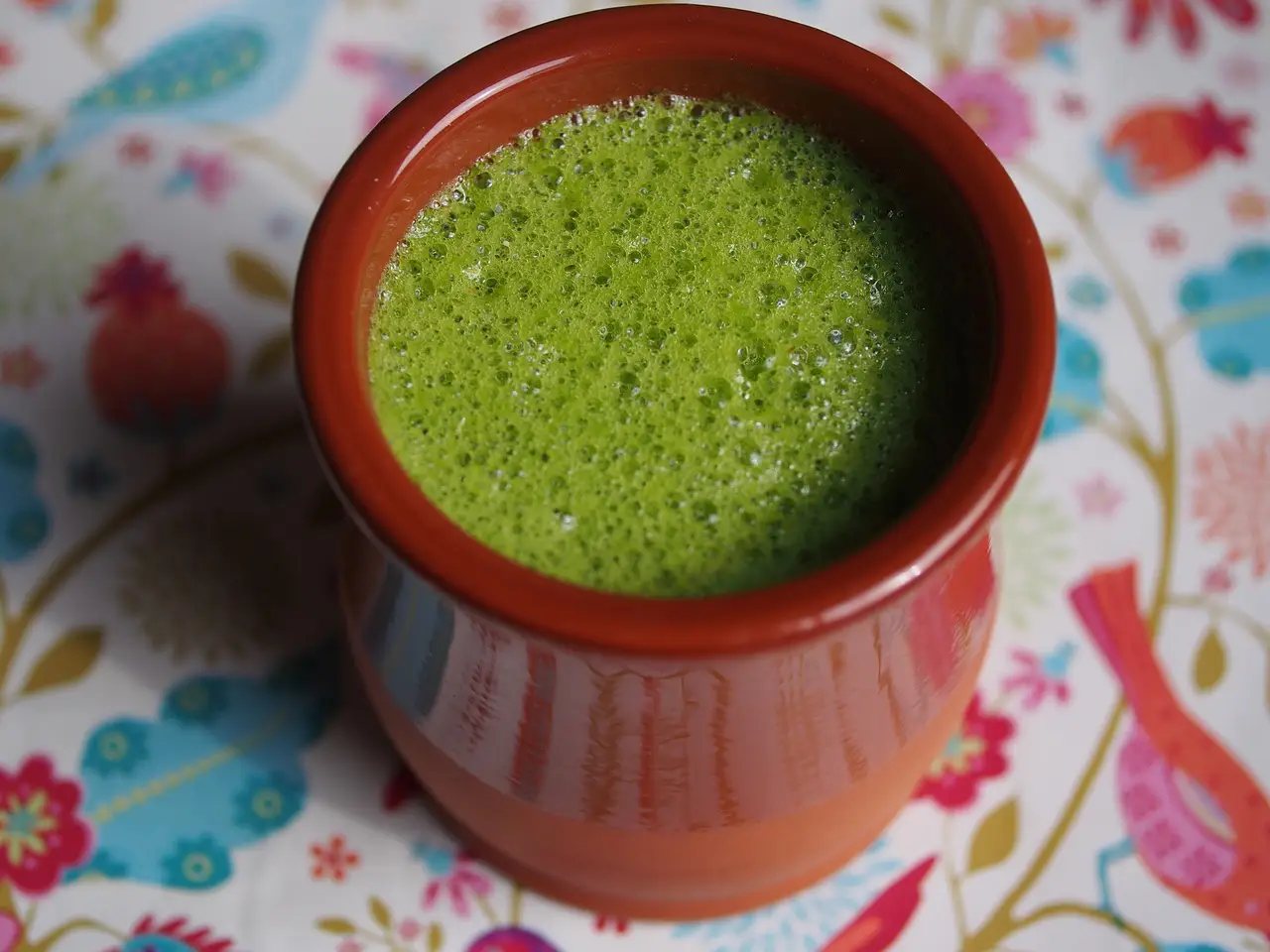
#3 Woof – Woof Smoothie
This is a vitamin and mineral bomb for dogs. They do not need it often, considering that you’re taking care of their diet, and do not contain enough calories to be regarded as a whole meal.But you can give them to your dog every once in a while!
Ingredients:
- ¼ cup bananas, apples, and pears (make sure there are no seeds)
- ¼ cup spinach, carrots, and zucchini
- ¼ cup any fruit juice (but steer clear of grape juice – it’s not good for your dog’s kidneys)
- 2 tbsp plain yogurt
- ¼ cup of water
- 1 tbsp Ricotta Cheese
Preparation time: 10 minutes
This is the most straightforward recipe; there’s no need for steps here. Simply toss everything into a blender, form a smooth consistency, and serve!
Oh, and serve it while it’s still fresh – only then the vitamins and minerals count.
What dogs is this recipe for?
- Those that need a healthy boost
- Suitable for puppies, as well
- Any weight and breed

This recipe makes doggo heckin happ!
#4 Winner winner chimken dinner
If you love cooking in bulk, this is an excellent recipe for you since it can withstand five days in a fridge without any risk. You can customize quantities to fit your needs. Plus your dog’s dental health will significantly benefit from it, since broccoli promotes fresh breath.
Ingredients:
- 5kg of diced chicken (breasts and drumstick mix, for Jimmy I substitute chicken with turkey )
- 5 eggs cooked
- 5 cups of rice
- 3 cups of chopped broccoli
- 3 tbsp olive oil
Preparation time: around 30 minutes
- Boil eggs
- Boil chicken and rice together until meat is nearly done
- Add chopped broccoli and simmer until the chicken is done
- Let it cool
- Add olive oil and eggs
- Let the munchies begin
What dog is this recipe for?
- Great for overweight dogs (chicken is lean)
- Great for dogs that must maintain weight
- Suitable for all dog of all breeds and ages (if not allergic to chicken)
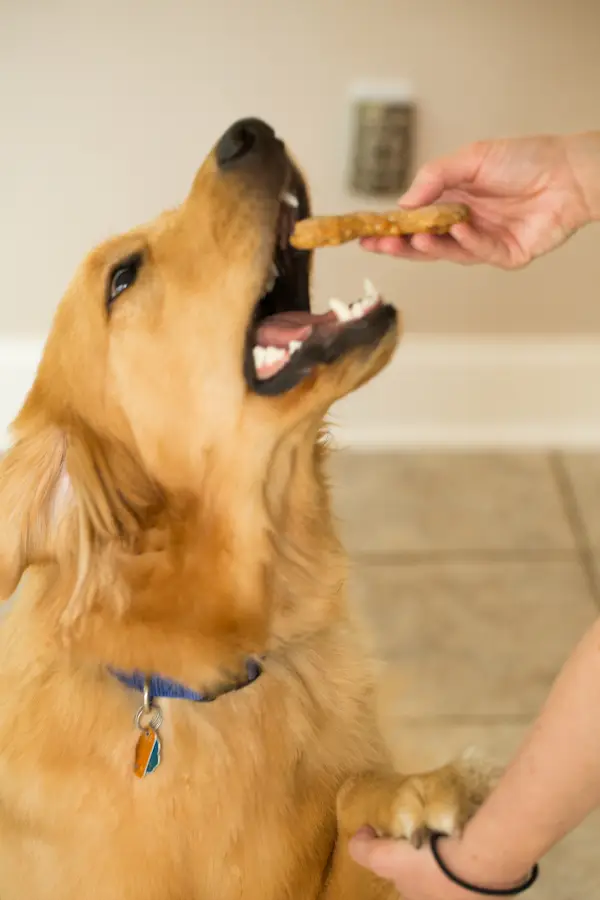
I gibbs paw, you gibbs treatos!
#5 Everybody loves mutloaf
Let’s be honest meatloaf is great comfort food, so treat your bestie right when he feels down.Remember how Lady and a Tramp shared a plate of meatballs? Well, if you have two lovebirds in your household, you can use this mix to recreate that romantic dinner.
Ingredients:
500 grams of ground beef
½ cup of cottage cheese
1 ½ cup of rolled oats
2 eggs
1 ½ shredded mix veggies (carrots, sweet potato, baby spinach)
Preparation time: 50 minutes
Preheat oven to 350˚F
Combine all ingredients in a large bowl using your hands
You can grease the loaf pan or put a baking sheet
Press the mutloaf into the pan
Bake for 40 minutes
Let it cool before slicing it
Serve to your pup
What dog is this for?
Suitable for doggos of all breeds and ages
Those who need cheering up
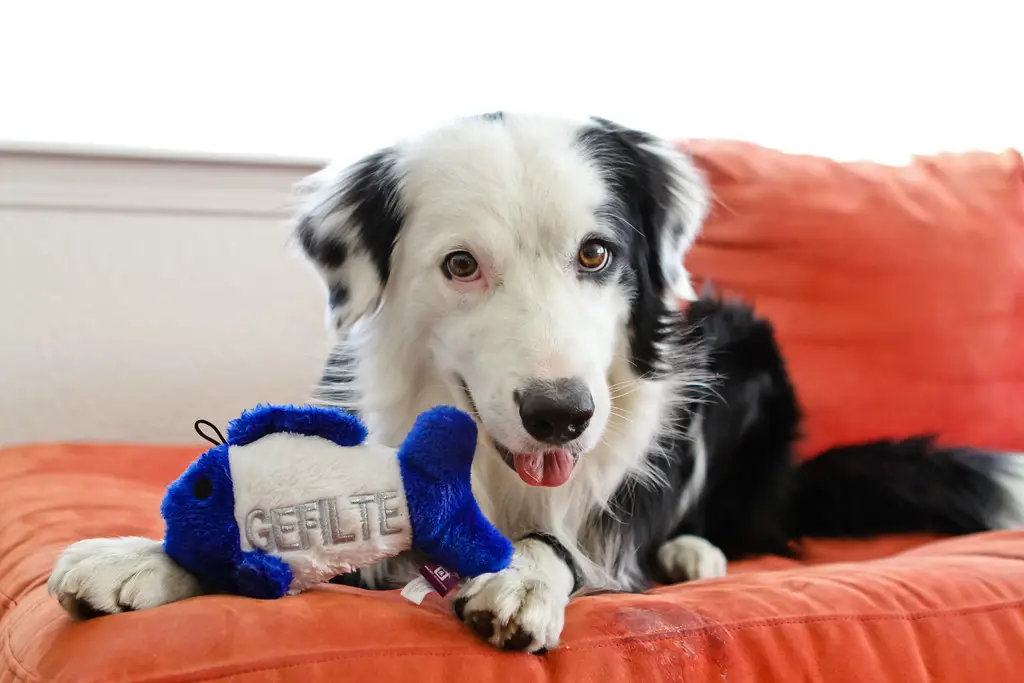
Can I has the fishy, pawlease?
#6 There is something fishy about this dinner
Not all pups are mad about fish, but you need to try it out before you can claim they don’t. What can be a better choice than pink salmon?
Ingredients:
- 2 portions salmon with skin (make sure no bones are left)
- 1 small head of broccoli
- 2 medium sweet potatoes
- 2 medium carrots
- 1 mall squash
- 2 tbsp olive oil
Preparation time: 30 minutes
- Preheat your oven to 400˚F
- Tear off two sections of foil and put each piece of salmon in it skin side down
- Put 1 tbsp of olive oil in each filet
- Wrap it in little packages and cook in the oven for 18 minutes
- Chop your veggies in small pieces and steam until cooked
- Mash the veggies
- Once all is cooked let it cool and mix together
- Feed your dog a fancy dinner
What dog is this for?
15 month old and up
Dogs who never tried fish before and ones who prefer fish
Make sure your dog always has access to a bowl of fresh water after a full meal.
Common Mistakes When Preparing Homemade Food For Your Dog

Silently judging you hooman!
The number of dogs suffering from food allergies and digestive tract issues is continuously increasing, which is alarming.
That is why so many dog pawrents decide to switch from kibble to homemade food.
When I started the transition, I was utterly lost. I made so many mistakes that I reached a level of frustration beyond any measure.
I was like I’m quitting, I’m done doing this, I’m incompetent to cook for my dog.
I wasted so much time, money, and food until I learned what food is a go-to and what is a no-go, how to organize his portions, and how to keep them edible for a more extended period.
So to avoid all my mistakes take a quick look at the rows below to learn from them.
Using unsafe and unhealthy ingredients – Using products whose origin is not familiar to you (especially when you feed raw meat) is very dangerous.
You risk infecting your dog with salmonella, E. coli, clostridium, campylobacter, Listeria, Yersinia, and many more.
Remember, some kinds of foods are more associated with foodborne illness and poisonings than others.
Make sure to learn all the steps you can take to prevent food poisoning; this will be beneficial for both of you and your tail-wagger.
Including protein that isn’t fat and meaty enough – Humans and animals are a lot different than you think.
We may prefer the lean cuts, but meat that you will use to feed your dogs must have at least 15% of fat (if you incorporate oils in their diets) but preferably 20% of fat.
Also, you may not prefer organ meats in your diet, but believe me, they do wonders for your dog’s overall health. They are high in nutrients like Vitamin B, iodine, magnesium, copper, folic acid, and iron. You can find out more about protein intake in this study.
Not following or not customizing recipes for your dog – It is very important to follow the recipe, but preparing a balanced meal for your dog isn’t just that.
You must always keep in mind the size, age, and breed of your dog. The next thing to keep in mind is food allergies if your dog has any find the best available substitute for the ingredient that is an allergen for your dog.
And lastly, if you decide to prepare food in bulk, do you know how to store them properly? It is not the same to prepare meals for an adult dog, a nursing dog, and a puppy.
They all require a different amount of nutrients. Not following recipes or customizing them for your dog can significantly harm the balance of meal, which makes all your hard work in vain.
Not consulting with your vet – I hope there is no need for me to hint to you how important it is to consult with your vet about your dog’s diet.
This is especially important if you want to make significant changes like switching from kibble to homemade food, particularly if you are considering feeding raw meat.
They will be a crucial help when you need to decide how to supplement your dog.
Never mess with your dog’s diet on your own. Your dog is your best friend, and you don’t want your best friend to suffer and hurt, don’t you?
Unfortunately, it is so easy to go wrong when it comes to feeding them homemade food, even though we do it with good intentions.
So on behalf of your dogs, I ask you to make sure you consulted with your vet before making any decision on their diet.
Final Words: Cooking Your Way to Your Dog’s Heart

Your dog is thankful you’ve read this article!
Learning how to cook for your dog can be overwhelming and frustrating; I learned that the hard way. But now I will tell you why it is more than worth it.
Take a quick look at your pup now. Do you see how lovingly he/she looks at you? Now imagine their goofiest face they make when they see you at the door — that little tail spinning like a propeller, am I right?
Their happiness is so contagious that you can’t imagine living without it.
So it is up to you to prolong their lives as much as you can. If they could do the same for you, they would do it without questioning. That is what the best friends are for.
Bear in mind that families that cook together stay together.




2 thoughts on “Homemade Dog Food – How To Cronch And Monch On A Pawsome Feast”
Comments are closed.